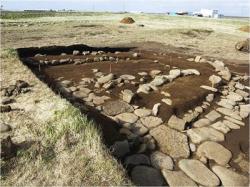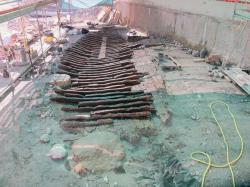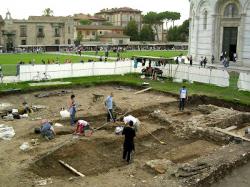INSTITUT SUPERIEUR D'ANTHROPOLOGIE
INSTITUTE OF ANTHROPOLOGY
ONLINE COURSES / COURS A DISTANCE
INSCRIPTION 2012 / Session III : Juillet 2012
REGISTRATION 2012 / Term III : July 2012
ISLANDE –  Hrafnseyri - Archaeologists Margrét Hrönn Hallmundsdóttir and Guðný Zoega recently began digging for human bones in the medieval cemetery at Hrafnseyri in Arnarfjörður in the West Fjords, bb.isreports. The cemetery lies below the modern day graveyard. The purpose of the excavation is to try to identify when the cemetery first came into use. Bones were discovered on the first day of the dig and have been sent for testing to determine their age. During the first centuries of the Icelandic settlement, Hrafnseyri was called Eyri. Iceland’s independence hero Jón Sigurðsson, was born in Hrafnseyri on June 17 (Iceland’s National Day). The place was later renamed after Hrafn Sveinbjarnarsson who lived there in the 12th century. Hrafn is considered to have been the first Icelander to seek an education in medicine. He reportedly travelled to the Salerno Medical School in Italy, which is thought to have been the world’s first medical school.
Hrafnseyri - Archaeologists Margrét Hrönn Hallmundsdóttir and Guðný Zoega recently began digging for human bones in the medieval cemetery at Hrafnseyri in Arnarfjörður in the West Fjords, bb.isreports. The cemetery lies below the modern day graveyard. The purpose of the excavation is to try to identify when the cemetery first came into use. Bones were discovered on the first day of the dig and have been sent for testing to determine their age. During the first centuries of the Icelandic settlement, Hrafnseyri was called Eyri. Iceland’s independence hero Jón Sigurðsson, was born in Hrafnseyri on June 17 (Iceland’s National Day). The place was later renamed after Hrafn Sveinbjarnarsson who lived there in the 12th century. Hrafn is considered to have been the first Icelander to seek an education in medicine. He reportedly travelled to the Salerno Medical School in Italy, which is thought to have been the world’s first medical school.
http://www.icelandreview.com/icelandreview/search/news/Default.asp?ew_0_a_id=391509
USA – Leetonia - The search is on for artifacts in Leetonia dating back to the 1800s. A group of Youngstown State University archaeology students have been at the Cherry Valley Coke Ovens site for weeks unearthing the historical land. The coke ovens were used in the 1800s through 1930s to develop fuel for furnaces in the iron and steel industries. Grids outline the property where the students are working. O'Mansky said the land used to house a storage barn. "These aren't just ruins here, but this was a place where a lot of people worked here, coming here everyday using these things we're finding," O'Mansky said. "So we're trying to figure out their lives as they worked here." The students' discoveries have been vast. "I thought this was a root, so I was brushing it off for a while and I accidentally stepped on it and it moved and here it's a pulley," said student Marie Everhart. Other finds have included a metal piece to a plow, china, medicine bottles, railroad ties and more.
http://www.wytv.com/content/news/local/story/Archaeological-Dig-Ongoing-at-Leetonia-Coke-Ovens/OSPEf5wJHE-6wrsTdGLWGA.cspx
GRECE - Eubée - Six anciennes épaves ont été découvertes au large du golfe de l'île d'Eubée, près d'Athènes, datées entre le IIe siècle avant notre ère et le IVe de notre ère, indique aujourd'hui l'agence de presse grecque (Ana, semi-officielle). Des amphores du Maghreb et de Sicile ou de Rhodes (sud-est de la Grèce) ont été retrouvées dans quatre épaves repérées à une profondeur de 37 à 47 mètres au large de l'île de Makronissos, dans le sud d'Eubée. . Les deux autres épaves datant des Ier et IIe siècle de notre ère ont été repérées un peu plus au nord du golf d'Eubée. Dans l'une d'elles ont été découverts des matériaux de construction et dans la seconde des amphores hellénistiques, la période de l'histoire de la Grèce ancienne entre 330 et 190 avant notre ère. Ces découvertes ont été effectuées par le service grec des recherches archéologiques maritimes. Au total 18 épaves ont jusqu'ici été découvertes dans le sud du golf d'Eubée, ce qui démontre que le secteur faisait partie d'une route maritime commerciale importante dans l'Antiquité, reliant le nord au sud de la mer Egée.
http://www.lefigaro.fr/flash-actu/2012/07/25/97001-20120725FILWWW00568-6-epaves-decouvertes-en-grece.php
FRANCE –  Antibes - À quelques encablures du port de plaisance d’Antibes, les archéologues de l’Institut national de recherches archéologiques préventives (Inrap) viennent de mettre au jour une épave romaine datant des IIe ou IIIe siècle après Jésus-Christ. Située au fond du bassin antique, qui s’est progressivement ensablé puis transformé en dépotoir riche d’objets – semelles de chaussures en cuir, bouchons de liège d’amphores –, elle est couchée sur le flanc dans un endroit peu profond. « C’était un voilier de commerce de taille moyenne (20-22 m de long) construit en bois de conifère, renforcé par endroits de plaquettes de plomb », explique Isabelle Daveau, responsable scientifique de la fouille. Cette épave illustre l’importance de l’antique Antipolis qui, entre Marseille et l’Italie, a longtemps joué un rôle prépondérant dans le commerce et la transformation des produits de la mer, notamment dans la fabrication de la sauce de poisson appelée « garum ».
Antibes - À quelques encablures du port de plaisance d’Antibes, les archéologues de l’Institut national de recherches archéologiques préventives (Inrap) viennent de mettre au jour une épave romaine datant des IIe ou IIIe siècle après Jésus-Christ. Située au fond du bassin antique, qui s’est progressivement ensablé puis transformé en dépotoir riche d’objets – semelles de chaussures en cuir, bouchons de liège d’amphores –, elle est couchée sur le flanc dans un endroit peu profond. « C’était un voilier de commerce de taille moyenne (20-22 m de long) construit en bois de conifère, renforcé par endroits de plaquettes de plomb », explique Isabelle Daveau, responsable scientifique de la fouille. Cette épave illustre l’importance de l’antique Antipolis qui, entre Marseille et l’Italie, a longtemps joué un rôle prépondérant dans le commerce et la transformation des produits de la mer, notamment dans la fabrication de la sauce de poisson appelée « garum ».
http://www.la-croix.com/Semaine-en-images/Decouverte-d-une-epave-romaine-dans-le-port-antique-d-Antibes-_NG_-2012-07-26-835725
ITALIE –  Pise - After compiling findings from the 2003 to 2009 archaeological dig under the Piazza dei Miracoli (Square of Miracles) in Pisa, scholars have published photos and drawings of the extensive previously unknown structures buried under the piazza. In 2003, while redoing the irrigation system under the grassy expanse around Pisa's Duomo and the Leaning Tower of Pisa, archaeologists uncovered a series of ruins that shed light on the usage of the area in the first millennium A.D., including an eleventh-century cathedral. Though the newly discovered cathedral had three naves, an apse, and a crypt, it was significantly smaller than the current duomo. It appears to have been left incomplete to leave space for the Romanesque duomo still present in the piazza today. When the piazza was the primary gateway into Pisa from the sea in the first century, it was occupied by a Roman domus, a mansion for members of the Roman elite, that was uncovered during the excavations. For the next six hundred years, more crowded and smaller dwellings occupied the space until they in turn were replaced by a nucleus of tombs. A seventh-century Longobard stone coffin discovered during the dig has fascinated scholars due to the rich clothing of its occupant, an upper-class man from the Cipriano family clothed in precious materials, including a silver belt buckle signed by the artisan di Mauro. The tomb's costly materials have been safe from looters due to its location near the Baptistry.
Pise - After compiling findings from the 2003 to 2009 archaeological dig under the Piazza dei Miracoli (Square of Miracles) in Pisa, scholars have published photos and drawings of the extensive previously unknown structures buried under the piazza. In 2003, while redoing the irrigation system under the grassy expanse around Pisa's Duomo and the Leaning Tower of Pisa, archaeologists uncovered a series of ruins that shed light on the usage of the area in the first millennium A.D., including an eleventh-century cathedral. Though the newly discovered cathedral had three naves, an apse, and a crypt, it was significantly smaller than the current duomo. It appears to have been left incomplete to leave space for the Romanesque duomo still present in the piazza today. When the piazza was the primary gateway into Pisa from the sea in the first century, it was occupied by a Roman domus, a mansion for members of the Roman elite, that was uncovered during the excavations. For the next six hundred years, more crowded and smaller dwellings occupied the space until they in turn were replaced by a nucleus of tombs. A seventh-century Longobard stone coffin discovered during the dig has fascinated scholars due to the rich clothing of its occupant, an upper-class man from the Cipriano family clothed in precious materials, including a silver belt buckle signed by the artisan di Mauro. The tomb's costly materials have been safe from looters due to its location near the Baptistry.
http://www.italymag.co.uk/
TURQUIE -  Ilisu River - Work on the new ‘Ilısu Protection Excavation’ is taking place at sites around Diyarbakır on a river that is soon to be controversially dammed. The excavation works at the southeastern province of Diyarbakır’s Ilısu River are soon to begin with seven local and two foreign teams. The works are slated to protect the areas that would otherwise be submerged after the construction of the contentious Ilısu Dam. The “Ilısu Protection Excavation” works will be located at Körtik, Salattepe, Karavelyan, Hakemi Use, Müslüman Tepe, Ziyarettepe and Hırbemerdon. The total number of excavation works will be 17,Diyarbakır Museum manager Nevin Soyukaya told the Anatolia news agency. Works at Hakemi Use and Salattepe have already begun and the other works will begin this year. Some of the excavations at other venues such as Aluçtepe, Gre Abdurrahman and Aşağısalat tumulus have already finished and very important discoveries have been made as a result of these excavations, Soyukaya said. Works will continue not only in the Bismil district, but also in other cities such as Batman, Mardin and Siirt, and all the areas around the lake have been excavated and taken under protection.
Ilisu River - Work on the new ‘Ilısu Protection Excavation’ is taking place at sites around Diyarbakır on a river that is soon to be controversially dammed. The excavation works at the southeastern province of Diyarbakır’s Ilısu River are soon to begin with seven local and two foreign teams. The works are slated to protect the areas that would otherwise be submerged after the construction of the contentious Ilısu Dam. The “Ilısu Protection Excavation” works will be located at Körtik, Salattepe, Karavelyan, Hakemi Use, Müslüman Tepe, Ziyarettepe and Hırbemerdon. The total number of excavation works will be 17,Diyarbakır Museum manager Nevin Soyukaya told the Anatolia news agency. Works at Hakemi Use and Salattepe have already begun and the other works will begin this year. Some of the excavations at other venues such as Aluçtepe, Gre Abdurrahman and Aşağısalat tumulus have already finished and very important discoveries have been made as a result of these excavations, Soyukaya said. Works will continue not only in the Bismil district, but also in other cities such as Batman, Mardin and Siirt, and all the areas around the lake have been excavated and taken under protection.
http://www.hurriyetdailynews.com/ilisu-river-dam-excavation-sheds-light-on-new-artifacts.aspx?pageID=238&nID=25970&NewsCatID=375